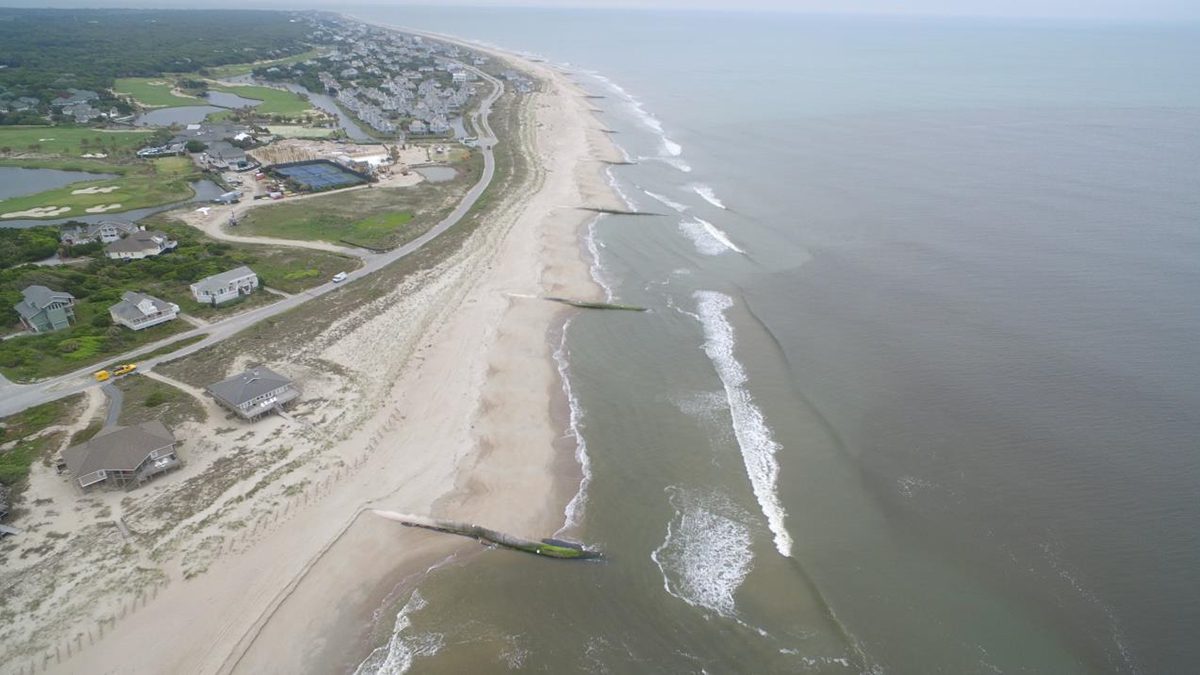
Bald Head Island could be the first beach town in the state to have two terminal groins now that the North Carolina General Assembly has amended the law that governs the number of such structures allowed on the state’s coastal shores.
Village officials were quick earlier this week to say that Senate Bill 607 gives them the option to pursue a study on whether a terminal groin would be a viable method of controlling chronic erosion at the east end of the island’s south beach.
Supporter Spotlight
Whether the village will move forward with such a study remains to be seen as the bill, which was ratified Friday, awaits Gov. Roy Cooper’s decision to sign, veto or let the bill become law.
Bald Head Island Village Mayor Peter Quinn on Monday sent an email to island property owners explaining why village officials had requested the change in the law, what the change means for the village and next steps.
“Such projects are very expensive and take years,” Quinn wrote. “The Village would not undertake such a study without any basis for a helpful solution. Any structure would be subject to extensive design, environmental study, public input, and state and federal permitting.”
A terminal groin has not been designed, planned or proposed, he wrote, and a multi-year investigation into whether such a structure would keep erosion at bay “will not be rushed.”
A terminal groin, as defined by bill, is one or more structures constructed at the terminus of an island or on the side of an inlet, or where the ocean shoreline converges with Frying Pan Shoals.
Supporter Spotlight
“Work to find a viable, financially responsible long-term answer needs to be environmentally sound,” Quinn stated. “Our community has, and hopefully always will, embrace the role of a steward whose actions are in harmony with its natural surroundings. We depend on this mutual idea and agents like the Conservancy to keep us on course.”
He is referring to the Bald Head Island Conservancy, an environmental and educational nonprofit that has publicly opposed the change to the law.
Last month, Bald Head Island Conservancy Executive Director Chris Shank was invited to make a presentation to the village council in which he argued whether a hardened structure would control the movement of sand on the east end of south beach, an area where sand is shifted by storms, which are unpredictable in frequency and strength.
Shank said in an email Monday afternoon that the conservancy was “very disappointed” legislators had passed the law, which also gives the village the option to explore replacing a series of fabric, sand-filled tubes on the west end of south beach with rock structures.
“I don’t believe the Village of BHI leadership or the NC legislators appreciate the monumental shift in approach to managing and protecting NC’s spectacular barrier islands that this legislation could bring,” he wrote. “Our barrier islands have always been one of our state’s most special resources, including our dynamic cape system whose constantly changing sands bring awe and wonder to those who experience them. Further, I doubt that North Carolina citizens want to armor their beaches to protect a limited number of private properties in the short-term in exchange for potentially much longer-term negative impacts to the rest of our beaches. I wish the Conservancy along with our research partners in the coastal physics and engineering fields had been offered the opportunity to discuss the potential consequences of this legislation with those who crafted and voted upon it. Then, at least, this baseline shifting decision would have been given the respect that it deserved for the citizens of Bald Head Island and throughout North Carolina.”
Bald Head Island was the first North Carolina beach community to build a terminal groin after the General Assembly repealed a decades’ old law prohibiting hardened shoreline erosion control structures on North Carolina’s coast.
The 2011 law authorized the Coastal Resources Commission to permit the construction of no more than four terminal groins under a pilot program. Legislators would later add that two additional terminal groins may be permitted. Senate Bill 607, if approved by the governor, will up the allowable number of terminal groins that may be permitted to seven.
Bald Head Island and Ocean Isle Beach are the only towns that have built terminal groins.
Village voters in 2014 overwhelmingly passed an $18 million bond to secure funding to build a 1,300-foot-long terminal groin at the western end of south beach, an area where the widening and deepening of the entrance to the Wilmington Harbor channel exacerbated sand loss.
“Changes in the island’s morphology at Frying Pan Shoals over the past few years have seen dramatic erosion and loss of beach habitat and property on the east end of South Beach,” Quinn stated in his letter to property owners.
The village spends anywhere from $1 million to $2 million about every five years to replace the cloth sand tube groin filed at south beach, he said. That groin field has been there since 1995.
“Replacing the cloth tubes with rock structures would save substantial public funds,” Quinn wrote. “These are not new or disappearing conditions.”
Village Manager Chris McCall described the tubes as, on average, stretching about 300 feet long.
Those tubes have proven to slow the rate of sand flow, he said. The law specifies that the field of rock structures may be groins, including T-head or lollipop groins, or breakwaters. The rock structures cannot be larger than the existing cloth tubes or greater in number.
These structures would have to be approved by the Division of Coastal Management or by variance from the Coastal Resources Commission.
Quinn said the village will dedicate a page on its website to keep property owners updated on its analysis of potential erosion control methods on the beach and when the public can provide input.
Note: Coastal Review will not publish Thursday in observance of Independence Day, a federal holiday.







